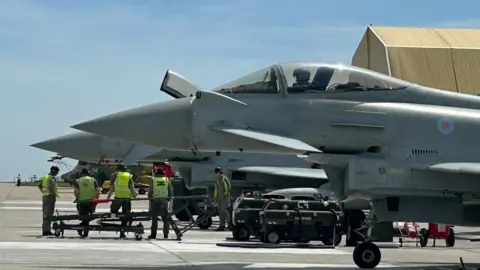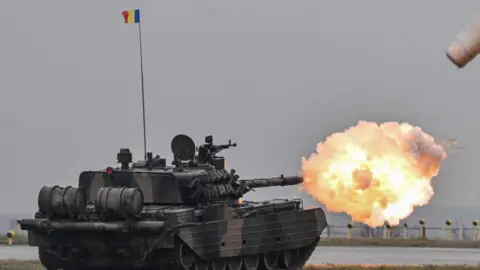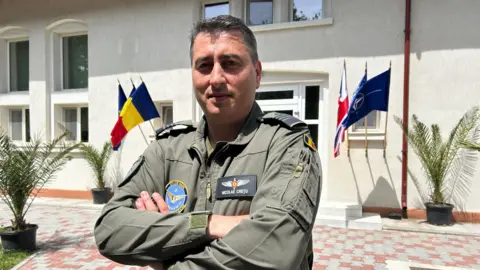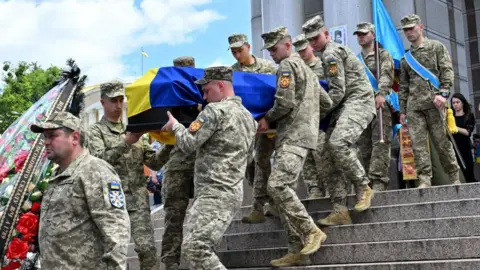By Nick Thorpe, correspondent in Central Europe
 bbc
bbcSix RAF Eurofighter Typhoons sit on the taxiway, engines roaring in two, as ground crews rush around, adding the finishing touches before take-off.
In the distance, in the middle of the summer fog, a cloud of dust rises over the construction of the second runway, 3.5 kilometers long, next to the first. The warm north wind whips the new and old hangars.
Mihai Kogalniceanu (MK) Air Base takes its name from the nearby village, which in turn is named after a 19th century liberal politician.
It is now the unlikely setting for what is becoming the largest NATO base in Europe, larger even than Ramstein in Germany.
Russian President Vladimir Putin justified his war in Ukraine by arguing that NATO is encroaching on Russia’s European flank. In response to his invasion, more pieces have advanced on the NATO chess board.
 fake images
fake imagesThe MK base will soon feature a squadron of Romanian F-16s – recently purchased from Norway – as well as MQ-9 Reaper drones, and a military city through which NATO army, air force and naval personnel will rotate. 32 countries.
The last to arrive are the Finns. Just 20 kilometers (12 miles) from the Black Sea coast, the base is 300 kilometers from Odessa, as the fighter flies, and 400 kilometers from Sevastopol, in Russian-occupied Crimea.
This is RAF pilot Lieutenant Charlie Tagg’s third and final tour of duty here.
“There is a much larger American presence here, much more infrastructure, accommodation, people and equipment.”
The Russian invasion of Ukraine has changed both the areas over which it flies, he says, and the strategic posture of the mission. In 2021, on their last tour, NATO fighter pilots flew far over international waters in the Black Sea. But now they stick to the 12 nautical mile zone over Romanian and Bulgarian territorial waters, “to avoid misunderstandings and escalation situations with the Russians.”

“Before, we were here as a deterrent against any Russian aggression. Now it is more of a guarantee for other NATO countries, like Romania, that we are here and we are ready to defend.”
There have been no calls to intercept a Russian plane since its arrival, he says, although there have been previous missions over the Baltic.
“They will just be wrong; It is not against any international law, they have the right to do it. But we will put a plane next to the adversary plane. From a posture standpoint, it shows the Russians… that we’re active. We fly with armed aircraft, so it sends a clear message.
“And it also provides us with valuable intelligence, we are recording the serial numbers of the planes and the weapons that those planes carry, so it also feeds the whole intelligence picture.”

Late at night, at the British MK base compound, he watches on his radar screens as the war unfolds in neighboring Ukraine.
“We could see Shahed drones entering Odessa. Heat sources on the ground, where weapons impact, feed into radars that track aircraft, both friendly and not-so-friendly aircraft. So it’s quite surreal.”
Although NATO planes avoid unnecessary encounters with the Russians, two incidents are known over the Black Sea. In September 2022, a Russian pilot misinterpreted a ground control order and he almost failed to knock down a British intelligence plane with a crew of up to 30 people.
In March 2023, an American MQ-9 Reaper drone, flown from Romania, was deliberately shot down by a Russian SU-27 “Flanker” aircraft, over international waters.
 fake images
fake imagesDaily life at the MK base, despite everything, is mostly quiet. In front of the office building of base commander Nicolae Cretu, seagulls and crows noisily pick a row of cherry trees. In his semi-permanent office, Scott Delay of American Army Support-Black Sea, plans logistics for the 1,840 U.S. troops the base currently supports.
“We try to give them a sense of home while they are here. So it’s really no different than any community. “It just has a fence around it.”
One thing American soldiers have a hard time getting used to, he says, is that delivery times for items ordered online can be weeks in Romania, rather than hours.
Before leaving the base, British pilot Charlie Tagg shows me his plane. Up close, the Typhoon looks powerful but a little aged. But weapons, he explains, are updated all the time. You can now throw three different types of bombs.
“And we are adding new radars that will allow us to detect and confront threats even further away.”

